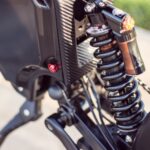Understanding MTB Helmets
Mountain biking is an exhilarating sport that combines adventure with a bit of risk. With every twist and turn on those rugged trails, your safety comes first. That is where mountain bike (MTB) helmets come into play. They are designed to protect your head from impacts, but with so many options available, choosing the right one can be a bit daunting.
In the world of MTB helmets, two popular types stand out: full face and half shell. Each has its own set of advantages and disadvantages, and the choice ultimately depends on your style of riding and personal preferences. Let’s dive deeper into the nitty-gritty of these helmets to help you make an informed decision.
What is a Full Face Helmet?
Full face helmets are like the armored knights of the cycling world. They cover your entire head, including the jaw and face, providing maximum protection. These helmets are typically made with a hard shell and an internal foam liner.
Benefits of Full Face Helmets
- Enhanced Protection: Full face helmets offer a high level of protection during crashes, especially in downhill and aggressive riding scenarios. The coverage protects not only your skull but also your face, which is invaluable in hard falls.
- Stability: With a more secure fit and complete coverage, these helmets tend to stay in place better during high-speed rides compared to half shells.
- Visor or Face Shield: Many full face helmets come equipped with a visor or a face shield, which can protect your eyes from debris, mud, and harsh weather. It’s like having sunglasses built-in, plus more.
- Neck Injury Reduction: The design can help reduce the risk of neck injuries during crashes, adding to rider safety.
Things to Consider
- Weight: Full face helmets are generally heavier than half shells. If you are cruising on flat trails or doing long rides, you might feel the extra weight after a while.
- Ventilation: While newer models are doing better in this regard, full face helmets typically have less ventilation compared to half shells. This can get toasty during those long climbs.
- Accessibility: Taking a full face helmet off can be a bit of a hassle, especially with the chin bar. If you plan on stopping frequently, this could be annoying.
- Price: Full face helmets can be pricier than their half shell counterparts due to the added protection and materials used. You might have to spend a bit more for that extra safety.
What is a Half Shell Helmet?
Half shell helmets are the more common style and have been around for a long time. They cover the top of your head and your back, leaving your face and jaw exposed. They are often lighter and more breathable, making them a go-to for many riders.
Benefits of Half Shell Helmets
- Lightweight: One of the main attractions of half shell helmets is their lightweight design. This makes them ideal for long rides where comfort is crucial.
- Better Ventilation: The open design allows for better airflow, which can keep you cool and comfortable on warm days or during intense climbs.
- Easy to Take On and Off: With no chin bar to contend with, putting on and taking off a half shell helmet is a breeze. This means easy access during breaks.
- Price Range: Half shell helmets are typically more affordable, which means great options are available for various budgets.
Things to Consider
- Less Protection: While they offer good protection for the top and back of your head, they don’t protect your face or jaw, which is a significant downside for aggressive riders.
- Stability: Some half shell helmets can shift around a bit more during rough rides. If you’re planning to tackle gnarly trails, make sure you get one with a snug fit.
- Versatility Limitations: If you plan on doing a variety of riding styles, a half shell may not be suitable for downhill or mountain biking, where the risk of falling is greater.
- Styling: While this is subjective, many riders feel half shell helmets lack the sporty aesthetic that full face helmets offer.
Choosing the Right Helmet for You
Now that we have dissected both helmet types, you might be wondering, “Which one is right for me?” Well, it really depends on your riding style, level of aggression, and comfort preferences. Let’s break this down further.
Your Riding Style
- If you are a casual rider: If you cruise around local trails or enjoy leisurely rides through the woods, a half shell helmet will likely suit your needs just fine. You get sufficient protection for your head and a more comfortable experience overall.
- If you’re more aggressive: If pounding down hills, tackling gnarly trails, or hitting jumps is your jam, a full face helmet is the way to go. The extra protection will give you peace of mind, allowing you to focus on the trail.
- If you do it all: If you find yourself exploring a bit of everything, look for helmets that might merge features from both styles. Some companies even offer convertible options that let you switch out the face guard.
Comfort and Fit
No matter which type you lean toward, comfort should always be a priority. An improperly fitting helmet can impair your enjoyment. Here are some tips for getting the right fit:
- Measure Your Head: Use a soft measuring tape to find the circumference of your head just above your eyebrows. This will help you determine your size.
- Try Before You Buy: If possible, try on helmets at a local shop. Things like cushiness, strap placement, and overall feel can vary widely between brands and models.
- Check the Snugness: A properly fitting helmet should not shift around on your head. Adjust the chin straps and be sure the helmet feels snug without being overly tight.
- Wear it Indoors: Wear your helmet for a while at home to see how it feels over time. If you start getting uncomfortable within a few minutes, try a different one.
Final Considerations
When it comes down to it, both full face and half shell helmets have their own unique charms. It all boils down to where and how you ride. Full face helmets provide the ultimate protection for aggressive riding, while half shell helmets offer versatility and comfort for more casual excursions. Personal preference plays a significant role too; some riders just appreciate the feeling of being fully covered, while others prefer light and airy.
Make sure you also consider features like weight, ventilation, and security. For example, I once had a helmet that was so well-ventilated it felt like I was riding with a fan, but it lacked padding. By the end of the ride, I was regretting my choice. So, prioritize what matters most for your riding style.
Wrapping Up
Ultimately, whether you choose a full face or half shell helmet, remember that the best helmet is the one that fits well and feels comfortable. Protecting your noggin while enjoying the thrill of mountain biking is key to having great adventures. So, ride smart, stay safe, and enjoy the trails!






